Best price on the market

How to plant cbd at home
Cannabidiol, better known as CBD, has gained immense popularity in recent years, emerging as a non-psychoactive component of cannabis highly prized for its potential health benefits. This growing attraction is not only limited to its use, but also to its cultivation, especially in the domestic sphere. Interest in growing CBD at home has been increasing, as it offers enthusiasts the ability to control the quality and purity of their plants, as well as being a rewarding activity. With a focus on personal well-being and self-sufficiency, home cultivation of CBD is becoming a relevant trend for those looking to make the most of its therapeutic properties.
To plant CBD at home, choose CBD-rich strains, prepare the right growing space, germinate the seeds, plant in pots with nutrient-rich soil, and provide adequate light, water, and nutrients. Maintain optimal conditions and harvest when the trichomes are ripe.
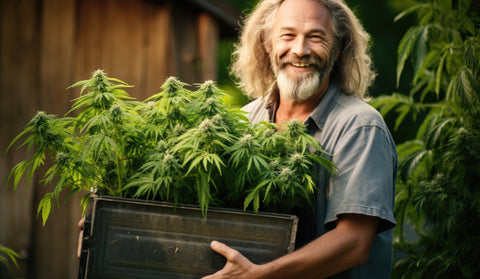
Is it legal to plant CBD at home?
It is crucial to understand the current legal situation regarding whether it is legal to grow CBD at home, as laws vary significantly from country to country and even between regions within the same country. Generally, the legality of growing cannabis plants depends on the content of THC, the psychoactive compound in cannabis. CBD-rich plants are often preferred for home growing due to their low THC content. In many places, growing low-THC (and high-CBD) cannabis plants is legal under certain conditions, such as for personal use or medicinal purposes. However, it is essential to check local laws before starting CBD cultivation at home.
In Spain, the legal situation surrounding the cultivation of CBD at home is regulated by the Citizen Security Law and the Citizen Security Protection Law, as well as the specific legislation of each autonomous community. Here are some important points to keep in mind regarding the legality of growing CBD at home in Spain:
- Number of plants allowed : In general, Spanish legislation establishes that growing cannabis at home for personal use is allowed as long as it is limited to a small number of plants. However, the exact number of plants allowed may vary depending on the autonomous community and local laws.
- THC levels : Spanish legislation distinguishes between the cultivation of cannabis varieties with high THC content (psychoactive) and varieties with high CBD content (non-psychoactive). Growing high THC strains is more heavily regulated and generally prohibited for personal use, while growing CBD strains may be subject to fewer restrictions.
- Regulation by autonomous communities : Each autonomous community in Spain may have its own laws and regulations regarding growing cannabis at home. Some communities may have stricter regulations, while others may have more permissive policies.
- Possible sanctions : Growing cannabis at home in Spain may be subject to legal sanctions if the number of permitted plants is exceeded or if it is used for illegal activities, such as drug trafficking. Sanctions can range from financial fines to prison sentences, depending on the seriousness of the crime.
- Safety Considerations : In addition to complying with local laws, it is important to take safety measures when growing cannabis at home in Spain. This includes keeping plants out of the reach of children, making sure they do not pose a risk to public safety, and complying with any regulations specific to the autonomous community in which you are located.
In summary, growing CBD at home in Spain may be permitted under certain conditions and limitations established by law. It is essential to familiarize yourself with local laws and regulations before beginning any cannabis cultivation activity, and it is always advisable to consult with a legal expert if you have specific questions or concerns about the legality of CBD cultivation in your area.
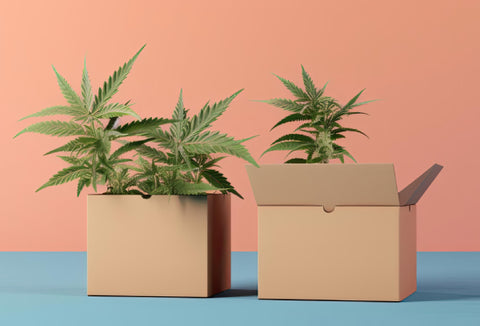
Advantages of Growing CBD at Home
Growing CBD at home has become an increasingly popular practice for those looking to take advantage of the benefits of this substance. Below, we'll explore the significant advantages of growing CBD in your own space.
- Guaranteed Quality and Purity : One of the most notable benefits of growing CBD at home is complete control over the quality and purity of the final product. As the grower, you have the ability to select organic substrates, avoid the use of harmful pesticides, and ensure that the growing process adheres to the highest standards. This quality assurance is especially important for those using CBD for health reasons, as it eliminates concerns about contaminants or unwanted additives often found in commercial products.
- Cost-Effectiveness : Growing CBD at home can be much more economical in the long run compared to constantly purchasing CBD products on the market. Although the initial investment for the equipment and seeds can be significant, the cost pays for itself over time, especially considering that a single plant can produce a considerable amount of CBD.
- Therapeutic and Educational Experience : The process of growing your own CBD plants can be a therapeutic and rewarding activity in itself. It gives you the opportunity to connect with nature and learn more about the life cycle of plants. Additionally, growing at home allows you to experiment and educate yourself on different strains and growing techniques, which can be an enriching and satisfying experience.
- Product Customization : When you grow CBD at home, you have the flexibility to experiment with different strains and growing methods to produce a product that exactly suits your needs and preferences. This is particularly advantageous for those using CBD for therapeutic purposes, as they can adjust the potency and chemical profile of their plants to meet their specific requirements.
- Sustainability : Growing CBD at home is a more sustainable option compared to industrially produced CBD. It reduces the carbon footprint associated with the transportation and manufacturing of commercial products and allows for a more eco-friendly approach, especially if organic growing practices are used.
- Independence and Autonomy : By growing your own CBD, you become independent from suppliers and market fluctuations. This not only gives you security regarding the constant availability of the product, but also protects you against variations in the prices and quality of commercially available CBD.
- Contribution to the Community : By acquiring skills in CBD cultivation, you have the opportunity to share your knowledge and experiences with other interested parties, thus fostering an informed and empowered community around the cultivation and use of CBD.
CBD Cultivation Planning
Planning is a crucial step in the process of growing CBD at home. One of the most important decisions you will make is the choice of growing location, whether indoors or outdoors. Furthermore, it is essential to consider climatic and temporal factors to ensure successful cultivation.
Indoor CBD Cultivation
- Environmental Control : Indoor growing allows you total control over the environment, including temperature, humidity, and light. This is ideal for creating optimal conditions specific to your CBD strain.
- Security and Privacy : Growing indoors offers greater security and privacy, protecting your plants from prying eyes and potential legal problems in areas where growing outdoors could draw attention.
- Continuous Cultivation : Allows cultivation throughout the year, regardless of the outside weather conditions.
- Considerations : Requires an initial investment in equipment such as grow lights, ventilation systems and climate control.
Outdoor CBD Cultivation
- Natural Benefits : By growing outdoors, plants can benefit from natural sunlight, which is excellent for CBD growth.
- Cost-Effectiveness : Lower initial cost since less equipment is used.
- Plant Size : Plants typically grow larger outdoors, which can potentially result in greater CBD production.
- Considerations : You depend more on weather and seasonal conditions. In addition, plants are exposed to natural pests and diseases.
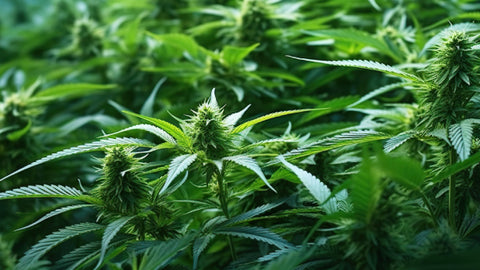
Climate for CBD cultivation
- Temperature : CBD plants prefer moderate temperatures (around 20-30°C). Extreme temperatures can negatively affect its growth.
- Humidity : It is important to maintain adequate humidity, particularly during the flowering phase. Excessive humidity can lead to mold problems.
- Sunlight : Plants need enough sunlight to grow healthily. In cloudier climates, you may need to supplement with artificial light.
Season to grow CBD
- Growth Cycle : CBD plants are generally planted in spring and harvested in fall.
- Day Length : Cannabis plants respond to changes in day length. During the summer, longer days promote vegetative growth, while shorter days in the fall induce flowering.
- Protection from the Elements : Outdoors, it is crucial to protect plants from extreme conditions such as frost, strong winds or heavy rain.
Selection of Seeds and Plants for CBD Cultivation
Proper selection of seeds or cuttings is a critical step in ensuring an effective and productive CBD crop. Here I will guide you on how to make an informed choice and the importance of opting for low THC strains.
Proper seed or cutting selection is crucial to ensuring a successful and productive CBD crop. Here I provide you with a detailed guide to make the best choice:
Select Specific CBD Strains
Opt for strains that are genetically engineered to produce high levels of CBD and low levels of THC. Some strains may offer a balance of CBD and other beneficial cannabinoids such as CBG or CBN.
- Charlotte's Web : This strain is famous for its high CBD content and low THC content. It is known for its ability to relieve pain, reduce anxiety, and control seizures.
- Harlequin : Harlequin is a hybrid strain that features a near-perfect balance between CBD and THC. It provides a mild and relaxing effect without producing significant psychoactive effects.
- ACDC : ACDC is another popular strain known for its high CBD and low THC content. It has been used to treat a variety of conditions, including chronic pain, inflammation and anxiety.
- Ringo's Gift : This strain is known for its high CBD content and low THC content. It is appreciated for its analgesic properties and its ability to relieve stress and anxiety.
- Sour Tsunami : Sour Tsunami is a hybrid strain that is characterized by its high CBD content and low THC content. It is known for its ability to relieve pain, reduce inflammation, and improve mood.
When selecting a specific CBD strain, it is important to consider your individual needs and preferences, as well as the growing conditions available.
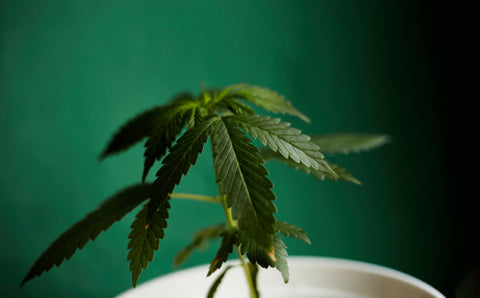
Consider the Type of Plant
- Regular Seeds vs. Feminized : Feminized seeds guarantee female plants, which are the ones that produce flowers rich in CBD. Regular seeds can produce male or female plants.
- Autoflowering : Autoflowering plants are easier to grow as they do not require changes in the light cycle to initiate flowering.
Evaluate Growth Needs and Characteristics
- Resistance : Look for varieties that are resistant to diseases and pests, especially if you are a novice grower.
- Climate and Environment : Make sure the variety you choose is suitable for the climate and growing conditions you can provide.
Investigate Growth and Performance Potential
- Size and Space : Consider the final size of the plant and make sure you have enough space for its growth, both indoors and outdoors.
- Yield : Some strains offer higher yields than others, which is important if you are looking to maximize CBD production.
Choosing High Quality Plant Cuttings
- Healthy Mother Plant : Make sure the cuttings come from a robust and healthy mother plant.
- Genetic History : Know the genetic history and performance of the mother plant to predict the characteristics of the cuttings.
Importance of Choosing Varieties with Low THC Content
Selecting low THC cannabis strains is crucial for effective and safe CBD cultivation. Here I highlight the key points about why this choice is so important:
- Legal Compliance : Many laws differentiate between THC-rich cannabis and that with high CBD and low THC. Opting for low THC strains is often essential to comply with local regulations and avoid potential legal penalties.
- Non-Psychoactive Effects : People seeking the benefits of CBD, such as pain relief or anxiety reduction, generally prefer to avoid the psychoactive effects of THC. This is especially relevant for those who use CBD for therapeutic purposes.
- Accessibility for All Users : Low THC strains are more suitable for a broader range of users, including those more sensitive to the effects of THC or who prefer to avoid them for personal or health reasons.
- Precision in Therapeutic Treatments : Growing plants with low THC content allows for more precise dosing of CBD, crucial for therapeutic treatments that require consistency and control.
- Lower Risk of Adverse Effects : THC may cause adverse effects in some users, such as anxiety or paranoia. Low THC strains minimize these risks, offering a safer experience for the user.
- Research and Development : There is growing interest in developing and studying cannabis strains with high CBD and low THC, reflecting progress in research into the benefits and uses of cannabis.
- Market Preferences : There is a growing demand for low-THC CBD products, which may present market opportunities for home growers.
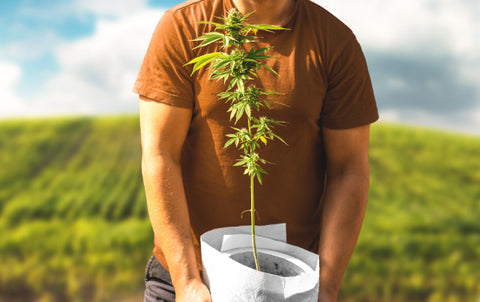
Tools and Products Needed to Plant CBD at Home
To ensure successful CBD cultivation at home, it is essential to have the right tools and products. Here I provide you with a detailed list of both the essential tools and the recommended products for the care and maintenance of your plants.
Essential Tools
- Containers or Pots : Choose containers of appropriate size for your plants, preferably with good drainage.
- Quality Substrate : A good substrate is crucial. Opt for mixes designed for cannabis that allow for adequate aeration and drainage.
- Lighting System : For indoor grows, you will need grow lights. Options include LED, compact fluorescent (CFL), and metal halide/high pressure sodium (HID) lighting .
- Ventilation System : It is vital to control temperature and humidity. Includes air extractors , fans and carbon filters.
- Digital timer : To automatically control light cycles.
- Temperature and humidity meters : To monitor the temperature and humidity of the environment.
- pH and EC meters : To measure the acidity of the water and substrate, and the electrical conductivity (nutrients in the water).
- Watering Can or Irrigation System : Essential for uniform and controlled irrigation.
- Pruning Tools : Sharp scissors for pruning and cutting.
Care and Maintenance Products
- Fertilizers and Nutrients : Select cannabis-specific nutrients, including nitrogen (N), phosphorus (P), and potassium (K), as well as micronutrients.
- Pest and Disease Control : Opt for organic and natural products to control pests and diseases, such as neem insecticides or insecticidal soap.
- Root and Growth Stimulators : Products that help root development and improve overall plant growth.
- Flowering Fertilizer : To maximize the production of CBD-rich flowers.
- Support Nets or Tutors : Useful to keep plants upright and properly distribute branches.
- Drain Trays : To collect excess water and keep the growing area clean.
- Pocket microscopes and magnifying glasses : To inspect the trichomes and determine the optimal harvest time. You can also learnhow to see trichomes without a magnifying glass , for example with smartphones.
- CBD/THC Measurement Kits : Although more specialized, they can be useful for measuring the cannabinoid content of your plants.
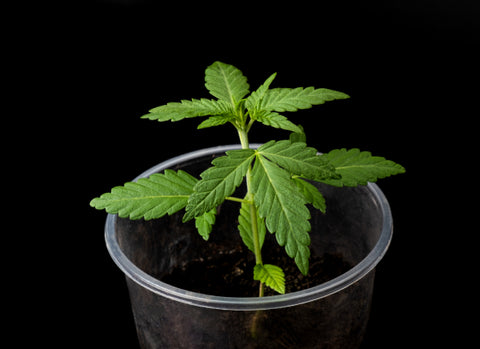
CBD Cultivation Process Step by Step
Growing CBD at home can be a rewarding and therapeutic experience. Here's a step-by-step guide that covers everything from planting to harvesting, along with essential tips on watering, lighting, fertilizing and pest control.
Preparation and Sowing
- Seed/Cutting Selection : Start with high-quality seeds or cuttings from high-CBD, low-THC varieties.
- Seed Germination : If you use seeds, germinate them by placing them between damp paper towels or directly in the substrate.
- Planting : Once germinated, plant the seeds or cuttings in pots with quality substrate.
Vegetative Growth Stage
- Lighting : Provides 18-24 hours of light per day. LED or HID lights are ideal for this phase.
- Watering : Keep the substrate moist but not saturated. Avoid excess water to prevent root rot.
- Fertilization : Use a nitrogen-rich fertilizer to promote vegetative growth.
Flowering Stage
- Changing Light Cycle : Reduce light to 12 hours a day to induce flowering.
- Fertilization : Switch to a fertilizer with higher phosphorus and potassium content to support flowering.
- Plant Support : Use stakes or nets to support plants as they grow and bloom.
Maintenance During the Crop Cycle
- Temperature and Humidity Control : Maintain a temperature of 20-25°C and a relative humidity of 40-60%.
- Pruning and Training : Practice pruning lower leaves and use training techniques to maximize light exposure and air circulation.
Irrigation
- Frequency : Water when the substrate is dry to the touch. Avoid excessive watering.
- Water Quality : Use water at room temperature. If possible, measure and adjust the pH of the water to a range of 6.0-7.0.
Lightning
- Intensity and Spectrum : Make sure your plants receive the right amount of light with the correct spectrum for each growth phase.
- Distance from Lights : Keep lights at an appropriate distance to avoid burns to plants.
Fertilizers for marijuana and CBD
- Follow Instructions : Use fertilizers according to the manufacturer's instructions.
- Nutrient Balance : Make sure your plants receive all the essential nutrients in the right proportions.
Marijuana Pest and Disease Control
- Prevention : Maintain a clean growing environment and regularly monitor your plants.
- Organic Treatments : Use organic and natural solutions to control pests and diseases.
Harvest and drying
- Optimal Moment : Observe the trichomes with a magnifying glass. When most are milky and some are amber, it's time to harvest.
- Harvesting Process : Cut the branches, remove large leaves, and hang the branches to dry in a dark and ventilated place.
- Drying : Let the plants dry for 7-14 days until the stems break when bending.
- Curing : Place the buds in airtight jars, opening them daily to air them, for at least two weeks.
